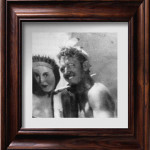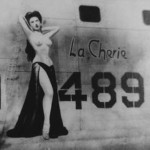“When Pearl Harbor was bombed, I was out of business,” says Hal Olsen in a way that only a 91-year-old veteran of WW II can say.
Transition rears its compelling and mandatory mindset in all military service branches and in any era. Helping hands in the process can come from different directions.
MilSuccessNet has recently featured two distinct kinds. One was The Valhalla Project, which you’ll find a gentle reference to heaven for warriors in this post and the other was the first of our 2013 Pin Up posts. Both have direct contact with veterans in common, and the desire to serve by assisting.
Now back to Hal Olsen and his life in art that helped then and heals and preserves memory of the times now.
Olsen had paid his dues, earned his stripes and served as a naval aviation mechanic of the P.T.O. or Pacific Theater of Operations while stationed in the Mariana Islands. It was a difficult reality for all. A time of adjustment.
Some time after the war, Olsen painted the Enola Gay onto canvas. He donated his painting of the bomber, the first to drop an atomic bomb, and the one that flew the retaliatory mission over Hiroshima, as well as other island scenery paintings to the Los Alamos Historical Museum.
“I worked there (in that region) for 25 years at the Los Alamos Scientific Laboratory (Los Alamos National Lab) as part of the illustrators’ group doing the art work. I did everything by hand, while the group moved to computer and then I retired in 1982.” Olsen continued as an artist post war and now post retirement.
Reunions of the original crew members meantime came and went. “No one really had cameras then like we do now,” says Olsen. Vets took black and white photos of his paintings, the ones that cheered them on.
“No one in the pin-up world today, knows what those girls looked like.”
He took 15 best samples of the more than 100 he painted and did them in color on canvas. These also were donated to the American Airpower Heritage Museum to be part of the commemorative air force. Only art of its kind that is left exists in the Midland Texas museum. Of 43 pieces saved from the campaign to recycle the aluminum from bombers to make pots and pans, 33 pieces have been preserved from other painters. “Easy Maid” is the only original piece in existence from Olsen’s work.
Olsen was invited to go to the Marianas in 2004 and to Pearl Harbor in 2007. He has given lectures at museums about his work, and at one the curator told him that it cost $10,000 to restore one painting. (View Hal Olsen and old Navy and Bomber squad photos here)
The value of his work has not been lost on Olsen. “The paintings were life-sized because the bombers were so large,” says Olsen. It appears their impact was large too.
Nose art personalized a piece of military hardware and brought a crew together. “It was like a signature for the unit,” says Olsen. “You trusted your life to the plane to get you back safely. You have to go through enemy territory.
By putting a girl on a plane, the crews felt they were protected on their way out to bomb and patrol. It inspired the crews and gave them a sense of belonging to an organized team. The main purpose, I guess, was to inspire the crews to have faith they’d be coming back.”
World War II nose art owes its existence to a tradition begun by sailors more than 400 years ago aboard the first sailing vessels. Carvings and paintings symbolized hopes of safe passage in the face of mysterious forces and unpredictable gods.
Nose art defined the WWII era. It adorned everything from war airplanes, to leather flight jackets, to the walls of barracks, huts and Officer and NCO Clubs across Europe and the Pacific. For many, “nose art” became memorial art, as over half of the young men serving in bomber crews would be killed or captured during their 20 mission tours.
Olsen’s art was again recruited to lift spirits of active duty men and women in the 2012 version of the Pin Ups for Vets calendar. His work appears alongside the WWII style pin ups in a calendar delivered to troops at home and in the field as part of its fundraising efforts in support of Military and VA hospitals.
For an update on Gina Elise and her 2013 Pin Up work read a recent post on her, with more to come on her calendar mates this year.


Speak Your Mind